Top 5 Sizzling Summer Landscape Design Ideas For 2018
“ I Go To Nature To Be Soothed, And Healed And To Have My Senses Put In Order.”
-John Burroughs
Ready to try something new this summer in your garden? Well, if you’re looking for hot, exciting, ideas you can use to spice up your landscape and make it stand out then you’ve definitely tuned into the right station. Whether you want to transform your outdoor space into a head-turning, masterpiece of nature or you simply want to spend your time outdoors among beautiful trees and flowers, we’ve got the ideas that can help you achieve it. Without further delay, let’s get straight down to business and have a look at 5 Top Summer Landscape Design Trends that have been taking the outdoors by storm.
- Revamping Lawn Areas

Have you ever noticed how a well-trimmed and maintained lawn has become a popular attribute that represents everything about the quiet suburban life?
Despite this, droughts, water shortages and rising environmental challenges in recent years have seemed to take their toll on many landscape designs including lawn areas. Nevertheless, instead of going with a traditional type lawn this summer people could consider planting grass mixes that don’t require mowing.
- Go Bold This Summer With A Colored Fence
This is probably one of the easiest, most cost-effective ways to enhance your landscape design and it not only sets the tone but really adds a certain highlight to the outdoor space.
A little color always makes things a bit more interesting – Add a slice of drama to your garden since the landscape design trends for this summer, dictate that using dark and bold colors for outdoor structures can give your landscape that extra boost and more for the eyes to feast on.
This should be a welcomed change from the traditional ‘white picket fence’ that has somehow gotten old.
- Natural Materials Add Texture Where Needed
In previous years when a more contemporary, landscape design concept reigned unopposed, it was one thing, but in more recent times, landscape designers have been getting more requests for the addition of natural elements and non-geometric styles, in order to exude a more natural and original landscape design.
Decks, swing seats, garden furniture, bird baths and small fountains all seem to be returning to the top of the list of trending ideas for summer landscape designs.
- Sustainable Watering Ideas To Match Environmental Conditions
With recent drought conditions showing no sign of letting up, keeping landscape designs in good shape has been proving to be a bit challenging for landscapers.
Since this is the case, this summer, why not jump onto the trend of low-water landscaping? Xeriscaping as it is more commonly referred to in landscaping circles is a landscape design that includes many drought-tolerant plant species that require little or no maintenance.
Not only does this form of landscape design help landscapers to promote water conservation in harsh times but they don’t have to spend so much time maintaining landscapes.
- Dog-Friendly Landscape Designs Are Great For Accommodating Your Pet
Most people who are dog owners are aware that dogs like to dig, so when planning your summer landscape design why not apply a few dog-friendly tips that you can not only have a beautiful landscape but a happy dog as well.
By making special areas throughout your outdoor space like sandboxes, for your dog to carry out its instinctual habit of digging, is a great way to avoid damage to your precious blooms while keeping your dog happy.
With Spring is reaching its zenith, landscapers everywhere are already into summer gardening mode. So, before you start pulling, raking and sowing, why not consider these summer trends to enhance and complement your landscape design.
If you need help with your landscape design or to start one from scratch, we’re here to help. The experts here at DK Landscaping have been helping gardeners all across California achieve the landscape design of their dreams.
Call us today at (707) 280-3632 to get started right away or you can visit our website at dklandscaping.com to learn more.
Frequently Asked Questions About Drip Irrigation Systems
“The Secret Of Landscapes Isn’t Creation …It’s Maintenance.”-Michael Dolan
Micro- irrigation systems or drip irrigation as it’s more commonly referred, is basically a form of irrigation that supplies water toplant roots in a gradual manner. Extremely popular for its efficiency and its ability to promote water conservation, drip irrigation systems consist of a network of supply veins which run beneath the topsoil throughout the specified area, to thoroughly and strategically deliver a constant supply of water to plants.
They’re probably plenty of gardeners out there who find drip irrigation systems work well for their gardens but might not necessarily know everything they should about irrigation systems.
Unfortunately, because of this they may run into a couple problems that they may not be able to solve, so this article aims to answer any questions relating to irrigation systems that may prove difficult to answer.
Understanding Drip Irrigation Systems – Frequently Asked Questions & Answers
Q: How do you know if irrigation drip lines are working?
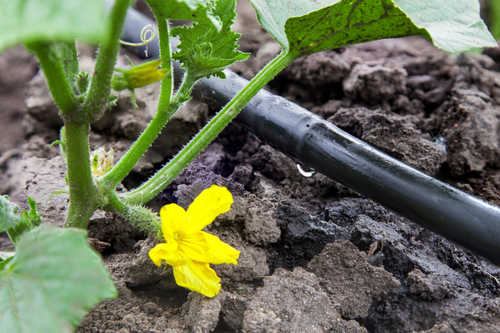
A: Since drip irrigation systems run beneath the topsoil it can be difficult to determine if it’s working. So, by simply observing the area after a few minutes of turning on the system to look for dampness in the soil around the line.
If your soil is mulched, just dig away a small portion of the mulch and soil with your hand and feel the soil to see if it’s moist or not.
Q: What’s the difference between a drip irrigation system and a ground sprinkler system?
A: Both systems function to deliver water to plants however a ground sprinkler system works by spraying a planted area above ground while a drip irrigation systems are located underneath the soil and deliver water directly to roots with a slow, consistent, drip.
Q: What type of garden is drip irrigation best suited for?
A: Drip irrigation systems are best suited for landscape beds with lots of plants and shrubs rather than lawns.
Q: How can a drip irrigation system benefit my garden?
A: Drip irrigation can offer gardens quite a few benefits once installed correctly. For instance, they prevent overwatering of plants and allow plant roots to absorb more water over a longer period of time, however some of the more popular benefits include its ability to promote water conservation, especially in drought-stricken areas and they offer a way for gardeners to save time and money.
Q: What difference will having a drip irrigation system make on my water bill?
A: As you can tell from its name a drip irrigation system practically drips water and emits water at a slower rate than above ground sprinklers or garden hoses.
With various settings, drip emitters may apply water at 0.5 – 4 gallons per hour where a rotor style sprinkler can water between 1 – 6 gallons per minute. See the difference yet?
You see, even though each landscape area differs in size drip irrigation systems can be set so that they have a slower application rate and higher efficiency. Based on this efficiency gardeners are able to reduce water usage by 50%. So, in other words, you’ll be cutting your water bill in half.
Q: Is a drip irrigation system difficult to install?
A: With easy to work with components, the process of installing a drip irrigation system is not difficult though there are certain guidelines you should follow. Basically, the process consists of weaving and arranging the tubing so that the supply of water is directed to the targeted areas.
Need Help With Drip Irrigation Systems?
If you don’t know how instal a drip irrigation system, don’t panic – help is just a call or click away. Don’t exhaust yourself spending hours in the sun struggling with irrigation tubes or worse stand in your garden and not know what to to to install your drip irrigation system. We can help.
Contact us at DK Landscaping Inc., to come in and assist you with professional irrigation system installation. Not only is our team knowledgeable about each aspect of irrigation installation but they will ensure you are well on your way without having to break a sweat. Call us today at (707) 280-3632 to schedule a visit or you can visit our website dklandscaping.com to learn more.
Learn How To Create The Perfect Xeriscape
When people say xeriscape they are referring to the practice of designing landscapes using slow-growing, drought-tolerant plants that aim to promote water conservation and reduce the need for regular maintenance.
Although recent drought conditions have created an urgency to adjust to different landscape practices like xeriscaping, many people still opt for xeriscape designs because they look amazing when finally complete.
Having said that, it’s important to remember that designing a xeriscape is not just throwing certain plants into some dirt and expecting them to look spectacular, it’s a process.
So, to help people to get a better grasp of things, we’d like to share some fundamental aspects on the best way to create the perfect xeriscape!
Accurate Designing Will Determine the Final Look
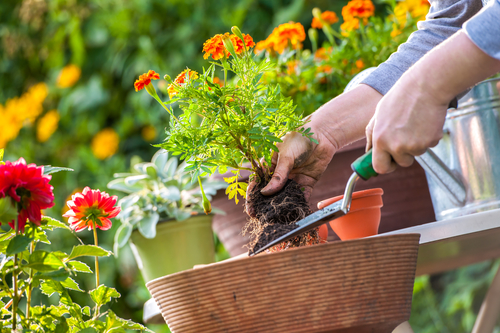
Now, to be as straightforward as possible, it’s important that people know that having plant material in the right place, is one of the most important aspects of xeriscaping.
Whether it be that you’re giving a facelift to an old landscape or designing a new one altogether, a proper design is vital – especially if you intend to conserve resources and achieve an amazing result.
Tips That Help With Xeriscape Design
- Assess the area for the presence of vegetation as this is an indication of whether plant material will grow well in that particular area.
- Arrange your xeriscape into of three different zones; a high water-use zone, a moderate water-use zone, and a low water-use zone. The high water-use zone should be very small, highly visible and watered as needed.The moderate water-use zone is usually a bit larger than the high water-use zone and is only watered when required. Now, the low water-use zone should be at least 60% of the area and only include plant types that are initially watered.
Using these straightforward tips you will be well on your way to creating a xeriscape design that’s efficient, practical, and easily maintained.
Soil Management And Soil Quality Is Important
Managing soil may probably be the part of xeriscaping that gardeners enjoy the least as it can involve a bit of hard work on their part but despite this, working with good, quality, soil while designing your xeriscape, is extremely important.
By knowing your soil’s strengths and weaknesses, you’ll know exactly what kind of amendments may be needed for healthy growth.
Nevertheless, always make sure to slope garden beds away from any buildings and plant drought-tolerant plants at the higher part of the slope.
Choosing The Right Plants
The best way to choose plants for your xeriscape would be to opt for more native plant species that may find it easier to adapt to your local environment.
It may be also smart to choose plants that have a slower growth rate that will mature with the rest of your landscape, add texture, and complement the surrounding area.
Here are a few plant choices you can use to make your xeriscape beautiful, functional and low maintenance:
- Southern Indian Azalea,
- Climbing Fig
- Creeping Juniper
- Sweet Alyssum
- Camellia
- Creeping Gardenia
- Jasmine
- Cleyera
- Indian Hawthorne
Why not let the professionals help you get started with creating the perfect xeriscape. Here at DK Landscaping, you can get the best xeriscaping services in California – Our professional team can come in and take care of all the hard work for you and all you have to do is sit back and watch you xeriscape mature and bloom.
Give us a call at (707) 280-3632 and our professional team will drop by to start the planning and preparation process. To learn more about our xeriscaping services you can also visit our website at dklandscaping.com.
How To Make Your Summer Landscape Design Stand Out
“The Poetry Of Earth Is Never Dead” – John Keats
Choosing plants for a Spring landscape can be pretty straightforward since many species thrive well this time of year, which is good, but if you’ve decided to switch things up and go for a summer landscape design instead, here’s how you do it.
When planning your summer landscape design you want to create the perfect mix of blooms that not only show resilience to heat but also make your landscape explode with life.
Well, here are a few insightful landscape design ideas that can help you to achieve the perfect landscape design this summer.
Use Heat-Tolerant Blooms in Landscape Designs to Beat the Heat
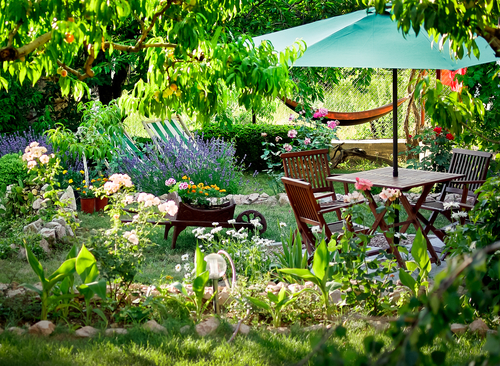
Various blooms can be damaged or destroyed in high temperatures so it is recommended that you use sun-loving plants that show exceptional resilience in heated conditions. Plants that can be planted in or before summer that thrive well in high temperatures can add a fresh and vibrant look to your landscape without compromise. Include heat-tolerant, summer-blooming plants like Zinnias, Verbenas, Latanas and Mealycup Sage in your garden.
Bring Your Landscape Design to Life with Lots of Color
Bring excitement and energy to your landscape design with bright and bold colors. Here are some great ideas you can use.
Opting to use species like Portulaca, a heavy blooming succulent, works well as a border in the landscape or “spiller” in your containers. Found in an array of colors such as white, orange and yellow while embraced by succulent foliage, this species is great for hot conditions and adds a bright, bold color combination to warm sun-kissed landscapes.
You can even go exotic by planting a little bit of every color or you can pair Portulaca with other sun-loving annuals or herbs such as pineapple sage, gomphrena or upright rosemary.
Add Variety and Contrasting Features with a Mixture of Color and Texture
You can pair plants together in order to create texture and to display color in any summer landscape design. You can even take things a step further by vamping up your foliage color with a bit of golden oregano mixed with varieties like ornamental peppers in yellow, orange or red.
Creating a kaleidoscope of colors contrasted by the velvety foliage of succulents adds an extraordinary texture and variety to your landscape and the best thing about them is they stay beautiful all summer long.
Make A Statement With Architectural & Modern Landscape Design Ideas
It’s not only the colorful, heat-loving blooms that make up the perfect summer landscape design but other important elements as well.
After planting your blooms and setting things in motion you want to put the finishing touches on your landscape design. Below are a few popular ideas that help you to put the icing on the cake by adding a contemporary flair to your surroundings while giving your landscape design that extra edge.
- Mulching – Provides additional color throughout the landscape and helps plants retain moisture.
- Fountains, bird-baths, garden furniture and stylish plant containers give a stylish effect that complements the entire landscape design.
- If none, adding certain hardscape features like, steps and walkways serves to accommodate traffic while adding extra appeal.
- Garden lights – Help to light walkways and give landscapes a certain ambiance at night.
Keep Landscape Designs and Regular Maintenance
Watering, pruning, deadheading and mulching are perfect ways to keep landscapes healthy and in superb shape. Supplementing landscapes with water up to twice per week or as needed is also very important – especially for containers and new color plantings. If you don’t have the time to water plants then perhaps installing an irrigation system can serve to supply water to landscapes in a timely manner without them being neglected or drying out.
Mowing, edging, raking and forking soil every now and then can also serve to keep landscapes clean and aerated while maintaining their appeal. If you need help establishing your summer landscape design, the experts here at DK Landscaping are here to help. Give us a call at (707) 280-3632 we install irrigation systems, design xeriscapes and hardscapes and offer landscape maintenance services.
For more information or to book an appointment you can visit our website at www.dklandscaping.com
Don’t sit there- Get started with your summer landscape today. Do you have a special design in mind?
A Closer Look at Irrigation Systems -Part 1
“Always Do Your Best. What You Plant Now You Will Harvest Later.” – OG Mandino
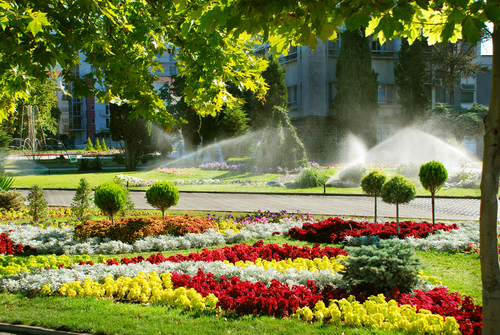 If you take a trip to your local garden center, in hopes of finding the right irrigation systems, you can become overwhelmed with what’s out there. Everything from automatic sprinklers to special hoses and spray nozzles can be found and if you don’t know what you’re looking for things are bound to get complicated. The good news is, it doesn’t have to be that way.
If you take a trip to your local garden center, in hopes of finding the right irrigation systems, you can become overwhelmed with what’s out there. Everything from automatic sprinklers to special hoses and spray nozzles can be found and if you don’t know what you’re looking for things are bound to get complicated. The good news is, it doesn’t have to be that way.
In scenarios such as this, the experts at DK Landscaping Inc. can help to simplify this entire process; We can come in and install a suitable and effective irrigation system so that watering is one less task you have to worry about.
As indicated in many historical records, irrigation has been around for centuries and dates all the way back to ancient times, however, over time, with advancing technology and more developed techniques, irrigation has become more of an applied science.
The Most Popular Irrigation Systems Being Used By Gardeners Today
LOW-DRIP IRRIGATION SYSTEM
Trickle irrigation or low-drip irrigation as it is more commonly referred, simply speaks about the type of irrigation method which allows controlled amounts of water, to drip slowly to the roots of plants through narrow tubes equipped with emitters.
With this method, water is delivered directly to the base of the plant and is mainly designed to promote water conservation, especially for gardeners who reside in drought-stricken regions.
Oh, and there’s more; gardeners can also efficiently irrigate non-turf areas such as flower-beds, vegetable and perennial gardens, ground cover and hanging baskets using this method.
It’s clear to see why this is one of the most popular types of irrigation systems used as it really takes care of a lot of areas that need a consistent supply of water on a daily basis.
Here’s How You Can Benefit From Drip Irrigation
- The efficiency of drip-irrigation saves time, money, labor and water.
- By minimizing water contact with the leaves, fruit, and stems of plants it prevents fungal disease.
- Discourages weed growth since water is delivered directly to plant roots.
- Increases effectiveness on uneven ground.
SPRINKLER IRRIGATION
Over time the methods and techniques used throughout gardens have not only grown to be more practical but creative as well. Having said that what better way to describe this next irrigation system but as a practical and creative one.
A sprinkler irrigation system uses a method that applies water to plants and soil in a manner that mimics natural rainfall. With this method, water is pumped through a system of pipes and is distributed in the form of a spray into the air, through sprinklers that break up the water into small drops and uniformly fall to the ground.
Take A Look At The Benefits That Sprinkler Irrigation Offers
- Can be used for both large and small plots of land.
- Conserves water by directing water flow to specific areas of gardens.
- Has the ability to administer fertilizers and chemical treatments through the system.
This type of irrigation system works well for people who have lawns, large gardens and practice farming. If you are thinking about having an irrigation system installed please don’t hesitate to contact us for more information. Look out for part 2 on this topic.
The Ultimate Guide to Landscape Maintenance -v2
No landscaper wants to see beetles, aphids, slugs or any other troublesome pests anywhere in their garden. Many of these pests are known to leave a path of destruction, destroying lawns, trees and plants wherever they go. Therefore when pursuing landscape maintenance, pest control is another important element that you may not want to forget. Even if it may look like just a few innocent bugs, infestations could rapidly spread, killing plants and trees along with your time and energy that you invested.
This is why it’s important that you visit your local garden center and speak to the staff there about the best pest control products to use to help you to keep pest at bay. It’s also important that landscapers make this a regular practice when conducting landscape maintenance to guarantee protection for your entire landscape.
Fertilizing
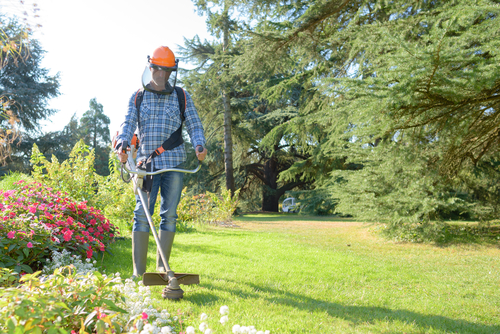
Fertilizing landscapes despite popular belief, is more than just throwing products into the soil and expecting something to happen instantly. Fertilizing takes time and should be done carefully and precisely if you are to get the best possible results. So when conducting landscape maintenance, so that you know what you’re doing, here’s a simple guide people can follow when fertilizing their landscape.
- Choosing A Fertilizer – Fertilizers can be purchased in a liquid, a granule, or a spike form and are mainly used to provide nutrients to soil and plants. Fertilizers when manufactured provide product information that includes an analysis such as 10-6-4, 5-10-5, or 30-7-7.
Here the first number represents the percentage of the nitrogen content in the fertilizer, the second number refers to the phosphorus content, and the third the potassium content in the fertilizer. This information is provided as an indicator to notify people of what exactly they’re purchasing and where it can best be used.
If you come across a fertilizer with these three major plant nutrients based on the NPK analysis, it is called a complete fertilizer and can be used to provide landscapes with a complete set of nutrients in one application.
- Fertilizing Trees – Depending on the landscape goals and what the current nutrient status of the soil is, landscapers can best determine how much and how often to fertilize trees, however, with small trees, these should only be fertilized once a year.
- Fertilizing Plants – Plants absorb fertilizer at any time during the growing season so long as it’s not too dry or the soil is frozen. Fertilizer is usually absorbed by plant roots during the dormant period, once soil temperatures stay above 40 degrees F.
Mulching
As part of landscape maintenance, mulching is also another important element that ought to be considered. Mulching is a great way to further promote health, vigor and beauty throughout your landscape and enables landscapers to benefit in numerous ways. This practice is known to support plant stability and provide nutrients to the soil while preventing weeds and maintaining consistent moisture levels throughout landscapes.
Think of how much time could be saved to do other things just by mulching, since you hardly have to weed or water landscapes. Apart from this mulching can also bring an extra sense of appeal while improving the aesthetics of landscapes, adding color and uniformity to the area.
Just like fertilizing, mulching should be done a particular way, wherein most landscapes mulch can be applied so it covers up to 3 inches above the soil and about 1 inch away from plant stems; As for trees, these can be mulched up to 8 inches off the ground.
People can also visit their local garden center to purchase mulch which can come in the form of wood chippings, bark nuggets, compost and much more. Grass clippings from your regular turf mowing can also be kept and used as mulch.
Don’t Have the Time to Conduct Landscape Maintenance? – Our Team Can Make it Happen for You!
Altogether, landscaping and landscaping maintenance can test the best of gardeners and is not for the faint of heart. Time money and lots of energy have to be put into creating and maintaining a gorgeous landscape.
If you’re retired, you work from home or landscaping is your profession then you may have more time on your hands to keep things with your landscape in order and even then there can still be numerous challenges as you may need help with several tasks. However, if you just don’t have the time or may meet certain challenges in different aspects of landscape maintenance, then we are here to help.
With top-rated landscape maintenance services, here at DK Landscaping we would be happy to come and give you a hand or conduct your landscape maintenance for you.With a knowledgeable, friendly staff, affordable rates and convenient services we can work to keep your landscape looking beautiful any time of year.
Operating efficiently and in any landscape environment, give us a call at to book your appointment or visit us online at dklandscaping.com for more information. Get your landscape maintenance done today, it’s just a call or click away.
The Ultimate Guide To Landscape Maintenance – v1
“A Landscape is a Living Space that Just Happens to be Outdoors” – GREG SOUTHARD
Didn’t quite get the most out of your gardening experience last season? Well, now that a new growing season is quickly approaching, you’re probably anxious to try a host of new ideas that you’ve included in your landscape maintenance plan which involves correcting all the things that went wrong last season.
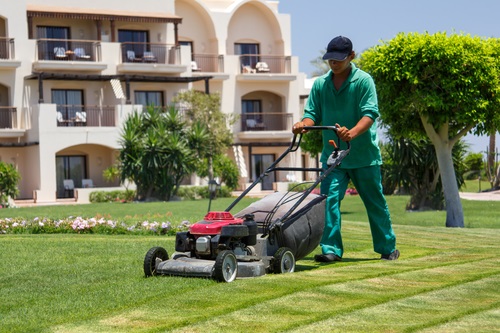
Well, what better way to get started this season, than with landscape maintenance? This not only gives you a chance to make wrong things right in your garden, but you can finally bring new ideas to life.
With that said, if you’re looking to achieve the best results, it’s highly recommended that you hire professional help, however it is still important that you make a checklist of all the areas within your landscape in need of maintenance so that you have a general idea of all the work that needs to be done.
Landscape maintenance can be a tedious task for any gardener or landscaper, however consistency is key. So after you have completed your initial landscape maintenance you might want to keep track of areas in your landscape that need constant attention if they are to stay well-maintained.
In this article, we’d like to discuss what many top landscapers consider to be some of the most important elements of landscape maintenance and how they should be used to keep landscapes fresh, beautiful and healthy.
Landscape Like The Pros! – Follow These Tips And Learn How You Can Maintain The Perfect Landscape!
Have you ever stood and admired a breathtaking landscape that was so beautiful, you wished it were your very own? Well, you can achieve the gorgeous, landscape you’ve always wanted. Apart from patience and dedication, following the fundamental elements of landscape maintenance can make your ultimate landscaping dreams a reality.
It’s really quite simple, landscape maintenance is very important if landscapes are to maintain healthy plants and trees.
There’s no landscaper out there who likes the ghastly sight of weeds or fungi in their garden, as these not only interfere with the look and health of landscapes but they rob the soil of essential nutrients and steal the sunlight that plants and trees need to thrive.
Here is a list of the most important aspects of landscape maintenance landscapers should follow to help them keep their landscapes lush and healthy while exuding beauty and sophistication. These include:
Turf Maintenance – Mowing
To commence with your landscape maintenance, you may want to begin with the largest areas of your landscape first, and mowing your turf is usually the best place to start.
One of the biggest concerns landscapers have with mowing turf is achieving a consistent, turf level throughout the landscape and though landscape maintenance doesn’t come without challenges there’s always a smart way to do things.
To make mowing your turf easy, start by mowing two strips around the perimeter of the turf and then continue by mowing in straight lines perpendicular to this; You can alternate the same pattern at every other mow if possible, until you cover the entire turf area. It may be a grueling task but once you stand back and take a look at the results, we’re sure you’ll be pleased with what you see.
In maintaining your turf this growing season, remember to mow weekly taking care not to remove more than 1/3 of the leaf blade at a time to ensure you maintain a sleek, level turf.
They say a good mower will mow wet turf and pick up clippings better, which once collected could be used later for other purposes like mulching.
Pruning and Trimming
Over the dormant winter period, when there’s not much, if any activity going on with landscapes, things can get a bit out of hand. Trees can accumulate lots of overgrowths, those that do survive the cold, while those that didn’t leave nothing but shells of branches and leaf litter behind.
At this point you know you have to do something to regain normalcy in your landscape, giving your trees, hedges, and bushes a chance to spring new life while helping to make things nice and organized again.
The trick to getting this done is to prune and trim trees and shrubs throughout your landscape; This keeps them looking attractive and producing new growth.
Pruning and Trimming is:
- Best done in the late Dormant Season
- To be done with the correct tools to avoid damaging or killing plants.
- A great way to avoid injuries and maintain safety in and around landscapes.
Even for some experienced landscapers pruning and trimming could be a bit complicated and if not done the right way could potentially kill a plant. This is one of the main reasons why it is recommended that people seek professional help when it comes to landscape maintenance as the professionals will know exactly what to do in these cases. Contact us for more information and look out for volume 2 of this topic.
Spring Fever? Check Out These Flower Bed Ideas!
Unlike that bad cold you had back in grade school, spring fever is something that you might actually want to catch. You know that you have spring fever if you’ve been planning out flower bed ideas and anxiously eyeing your garden for signs that you can start planting.
From annuals and pair bulbs to spring containers and early bloomers like petite flowers, there are steps that you can start taking today to make that spring fever work for you. The best place to start might be spring-blooming bulbs like daffodils and hardier annuals.
Think Daffodils, Snapdragon, Stock Flowers, Sweet Pea and Hyacinth
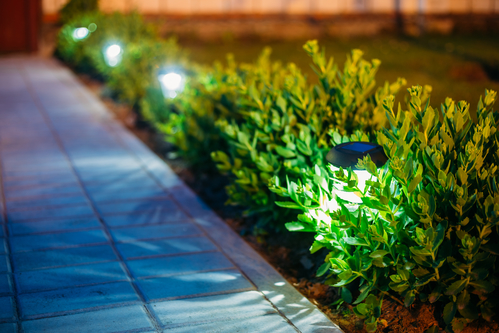
Hardy and half-hardy annuals are the way to go right now if you’ve got a green thumb and you can’t manage to set still. Half-hardy annuals like calendula and snapdragon flowers can withstand a light frost or two and add a full palette of color to your early spring garden.
- Calendula and Dianthus Flowers
Calendula flowers are sometimes known as pot marigold flowers and they’re great because they self-seed so that a handful of seeds really does go a long way towards beautifying your garden. And if you’re looking to add some nice clove scents to your garden, you might also want to throw in a few violet-colored dianthus flowers (growable in containers).
- Snapdragons are Very Hardy
If you’re in a climate that gets truly cold even into late winter, what kinds of flower bed ideas would actually be useful? Well, snapdragons are considered one of the toughest winter hardy flowers in the business since they can come back to full blossom even with significantly subzero temperatures.
- Keep Stock Flowers Around
Stock flowers are also fairly hardy, although they do best in spring and tend to wilt somewhat when summer rolls around. Because they have such a wonderful scent, though, you might consider tucking a container full of stock flowers in the back of your summer garden once they’ve started to wilt come late June.
- Daffodils and Hyacinths
Large bulbs with daffodils and hyacinths are always good to plant alongside your winter hardy flowers in early spring for the extra color and variety that they lend to a spring garden. Whereas peonies and lilacs like to bloom later on in the spring season, daffodils and hyacinths can start a little sooner and give you a head start on your summer garden.
Intersperse Flowering Shrubs with Your Flowers
You really want to think about your spring garden as more of a spring garden landscape. You’re going to be bringing together a lot of different colors, textures, and scents to create a full-on experience. Flowering shrubs look great, smell wonderful, and can even offer the partial shade that daffodils and hyacinths sometimes blossom best under.
- Forsythia Bushes
If you’re in a true four-seasons climate that’s more adventurous than tranquil year round, you might want to consider adding a few forsythia bushes to your spring garden landscape. Forsythia bushes are considered early bloomers, so you can expect to see forsythia’s yellow flowers beautifying your backyard oasis in plenty of time for spring.
- Azalea Blossoms
For more temperate climates where the temperature doesn’t get too cold in late winter or early spring, you should definitely check out azalea blossoms. Azalea is a veritable fixture in the Southeast part of the United States because the ubiquitous good weather there provides the partial shade and leaf litter that azaleas need to thrive and reach their potential.
For more flower bed ideas and advice about how to improve the look of your yard, contact us at DK Landscaping. We provide all our clients with maintenance, repair, irrigation and water savings tips.
Why You Should Be Mulching Your Garden
“The Love Of Gardening Is A Seed Once Sown That Never Dies” – Gertrude Jekyll
You ask why mulching? Well here’s a logical answer to that question, you see at the beginning of each growing season it’s typical for most landscapes and gardens to carry a rough and lifeless look. Rain and snow from last winter certainly seem to take a toll on a landscape that was thriving only a few months before.
Despite this, you put on your gloves and get started with preparing your garden for the upcoming planting season. Perhaps you’ve cleared the garden beds of last year’s leaf litter, laid down fresh soil and already planted a number of new plants.
Sounds promising but there’s still one thing you haven’t done to ensure the health and longevity of this season’s plantings and if you didn’t know, mulching is a popular gardening technique which basically uses certain organic and inorganic materials to cover soil.
Learn How Mulching Can Help Gardeners Achieve Appeal
Over time, mulching has proven to be a very effective gardening technique that lends help, protection and nourishment to blooms. In fact, gardeners who utilize mulch are guaranteed to see fantastic results throughout their garden.
Despite popular belief, mulching a garden goes way beyond modern, garden aesthetics and is more than just a colorful addition that complements a home’s exterior.
If you take a trip to your local garden center you’ll see that there are plenty of garden-bed coverage options available, that can benefit your garden one way or the other, however the big question is are they as effective as mulch?
The answer to that may very well be no since mulch can serve many purposes in gardens as opposed to using a number of different gardening products to achieve the same results. Firstly, because most forms of mulch are organic, they tend to help plants absorb and retain moisture, as well as to slow the process of evaporation from the soil.
Secondly, mulching is an excellent way to mitigate overwatering gardens by absorbing a great deal of the water that would otherwise waterlog the soil. Aside from this, when temperatures begin to soar in the summer, mulching plays an integral role in the health and growth of plants by maintaining the right amount of moisture when it gets too heated.
So in essence mulching is the perfect way to maintain consistent moisture levels in gardens when it’s heated since too much water can be just as bad as not enough water.
Mulch Offers Protection From The Elements So You Have Longer Lasting Blooms
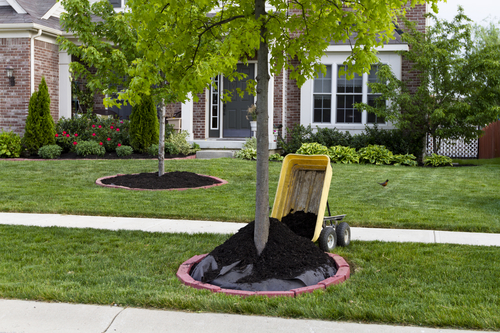
Any gardener knows that it’s inevitable for a garden to endure extreme conditions when the seasons change each year, so finding effective ways to offer plants protection is always something that gardeners have to take into consideration.
Again, mulching can serve as the ideal solution since it acts as a formidable shield against the elements. On extremely hot or windy days, mulch can effectively serve as insulation to prevent the evaporation of water from plants and during cold periods, it captures heat from the sun to help regulate the temperature of the soil. Additionally, it offers exceptional support to plants and stability to the soil, to help plants to stay firmly rooted, where gardens are situated in extremely windy regions.
Can You Say Weed Control? – Say Goodbye To Menacing Weeds With Mulching
Weeds are a gardener’s worst nightmare and though they can’t be avoided completely if left to grow, they can choke and hinder the growth of plants. Covering soil in mulch pretty much deprives weed seeds of the light they need for germination and since it also prevents weed seeds from coming in contact with the soil, they are not able to fully take root.
Mulching? – Take A Look At The Most Popular Types Of Mulch Gardeners Use
With all this talk about mulch and the exceptional benefits it offers you’re probably wondering which materials out there are best to use for mulching. Well, to be honest mulch can come in many forms but it is said to be more beneficial when used in an organic form.
Here are some examples of natural materials that can be used for mulching. These include:
- Wood Chips
- Grass and Straw
- Pine Needles
- Bark Nuggets
- Compost
- Leaf Litter
Organic mulches have been discovered to not only offer protection and heat to plants when they break down but they also provide essential nutrients and improve soil quality as well.
Some Gardeners Find Inorganic Mulches Work Well
Gardeners who do vegetable gardening or are into agriculture, tend to utilize these particular types of mulch more since apart from their typical benefits, they also serve a unique purpose. Some of these include:
- Gravel
- Stones
- Geotextiles
- Black Plastic.
Uniquely, inorganic mulches serve as an effective form of pest management but along with this they help prevent root rot, allow for increased air permeability and permit easier rainfall penetration to plant roots.
So depending on the gardening environment, the choice of mulch used is usually determined by what is being grown and the existing conditions within a particular garden.
Since this article wouldn’t be complete without making mention to how mulch is applied in a garden, we’ll get straight into the juicy details on the right way to apply mulch.
No More Mistakes – Mulching The Right Way Brings The Best Results
Though many people may be under the impression that mulching is nothing more than spreading a bit of grass or wood chips at the top of garden beds, FYI it’s not. Mulching is actually a very beneficial gardening technique should it be done accurately.
To give you a better idea of how you should really be applying mulch, here is a definitive guide to mulching the correct way. Follow these steps and you’re sure to see mind-blowing results.
- Firstly, you will have to make an honest determination of how much mulch you will need to buy to get adequate coverage throughout your garden, especially if it is to be laid down nice and thick. ( Be careful not to add too much mulch as you can suffocate the plants)
- Once you’ve purchased your mulch and ready to go, your next step would be to give your soil a good turning and apply any product nutrients such as fish meal or blood meal before you lay down your mulch.
- For gardeners who are mulching to combat weeds, it is important that you must first remember to weed the soil beforehand. This is essential if mulching is to be done properly and for it to be effective and secondly it should be laid down thick enough to discourage the reappearance of new weeds.
- Now it’s time to lay down your mulch. When using organic mulches like shredded bark, wood chips or leaf litter, these should be laid down about 3 inches deep and shredded hardwood spread no more than 2 to 3 inches deep. For mulch consisting of coarse bark nuggets 3 to 5 inches deep should suffice and for landscapes that include trees, these can be mulched at about 8 inches off the ground.
- Although the laying of mulch is fairly easy, HOW it is placed is another thing and if not done correctly, can hamper plants. Therefore, when laying mulch down, it should be kept no less than an inch away from the crowns and stems of plants. This is mainly because wet mulch resting against the stems of flowers and vegetables can cause rot. So without further ado, it’s time to get started.
What’s your favorite type of mulch? “Personally, I’m a black mulch, shredded wood kind of gardener.” – Garden Enthusiast.
Do you need help mulching? Don’t know what mulch you should get? Call us at DK Landscaping we will gladly help you with mulching your garden. We also provide expert advice on the best mulch to use for your garden and even help you pick it out at the store.
We can mulch your entire landscape and take all the stress off your hands. Contact us at (707) 280-3632 to schedule your appointment or you can also visit our website dklandscaping.com for more information on our services.
Top Gardening Trends For 2018 – Create Your Santa Rosa Xeriscape
Santa Rosa Xeriscape – The Way to go!
Water conservation has become a big deal these days in Santa Rosa and in several other cities in California, since the state has been experiencing severe drought conditions in recent years. Here, authorities have been forced to implement specific regulations and water restrictions in order to facilitate the conservation of water throughout the state.
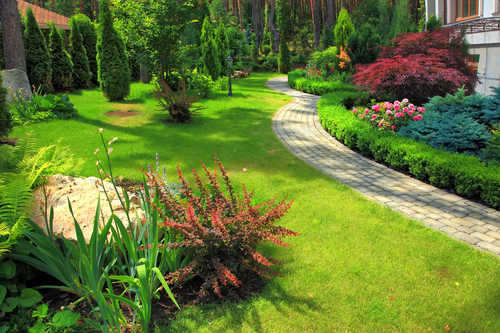
As a result of this many gardeners and landscapers in those areas have had to improvise with their gardening techniques and have been utilizing xeriscaping to keep their gardens in tip-top shape in harsh and limited conditions.
Xeriscaping can bring a whole new meaning to your gardening this year even if the area where you reside is not as dry as others. This technique can help you to save, spend less time watering plants and play your role in conserving water in your district.
FYI – Xeriscapes Make Things Easy For Gardeners Battling Drought
If you live in Santa Rosa or any other city in California that’s drought stricken, then you know that maintaining a healthy and well-nourished garden can be quite the task. Not only because of the harsh and conditions that can exist in some areas but also because of the many issues concerning water conservation.
This is certainly a discouragement for many gardeners as they may fear the worst for their gardens with water regulations being so strict, however there is hope. With your Santa Rosa xeriscape, all your gardening dreams can be made possible and you can still remain compliant with California’s Water Regulations. How?
Well, this particular type of landscaping is specially designed to reduce or eliminate the need for supplemental water to plants, making it easy for gardeners to maintain gardens or landscapes in the scarcity of water. Your Santa Rosa xeriscape does not have to be limited to a single look but can achieve almost any landscaping style conceivable. So whether you have a small garden or are responsible for maintaining a large landscape, using this concept won’t pose any issues with your gardening experience.
Furthermore for your Santa Rosa xeriscape, gardeners can choose from a host of attractive plants that not only show exceptional resilience to harsh conditions but also add variety and appeal to gardens.
Learn How You Can Achieve The Perfect Santa Rosa Xeriscape Following These Easy Steps
The fundamental element of xeriscape design is water conservation, making it the perfect solution for landscape designers who’re constantly searching for ways to reduce the amount water applied to their gardens and to maximize the use of natural precipitation.
Switching to xeriscaping from the more traditional way of landscaping is really quite easy and can be done by any gardener, however, whether you want to redesign an old landscape or create a fresh new, one using xeriscaping, there are a few basic principles that must be followed. These include:
- Planning
To kick off your Santa Rosa xeriscape project, planning is the first thing you should do, where you begin by constructing an aerial view of the site using graph paper, and then marking down North, South, East, and West.
Next, any limiting features such as trees, fences, walkways or structures should be included in plans, noting areas of full sun and full shade to help you to establish areas with different water requirements. You’ll also want to group plants with similar watering needs for most efficient water use.
It is also suggested that gardeners plot areas for seating, walkways, visual barriers, dining or play into plans; carefully constructing a section where larger plantings, such as shrubs and trees can be positioned to provide natural heating and cooling opportunities for adjacent buildings.
Lastly, study the natural contours and drainage patterns of the site to better understand the best or worst location for plants. These contours can be easily developed into terraces, which help to add visual interest and reduce soil loss and erosion.
- Soil Improvement
The next step to creating the perfect Santa Rosa xeriscape would be to improve soil quality on the site. In water-scarce landscapes having the ideal soil conditions does two things: it drains quickly and retains water at the same time. This is achieved by increasing the amount of organic material in your soil and keeping it well aerated.
All you have to do is to purchase some compost from your garden center to help increase the organic matter in your soil, though if you intend to use succulents and cacti in your Santa Rosa xeriscape you may want to work at achieving a leaner soil.
Adding bone meal and rock phosphate to the soil is also another way to boost soil volume and help to improve soil quality, however this is usually done with soils testing a high pH (too alkaline) and low in phosphorus.
- Create Limited Turf Areas
Next, you will need to reduce the size of turf areas as much as possible while retaining an area for open space, functionality and visual appeal. If you intend to plant new turf or reseed an existing lawn, it may be sensible to purchase water-saving species plants adapted to your area from your garden center. This brings us to our next step.
- Use Appropriate Plants
For gardeners to achieve the best results with their Santa Rosa xeriscape, they should select drought-resistant plants native to their region. The plants selected should have leaves which are small, thick, glossy, silver-grey or fuzzy – all characteristics which help them save water. It is also important to choose plants for their ultimate size which will reduce the need for pruning maintenance, especially in hot and dry areas.
Keep in mind to place plants along North and East-facing slopes and walls, that like more moisture but most importantly, it’s best not to mix plants with high and low-watering needs in the same planting area.
- Mulch
Most seasoned gardeners already know that mulching is a great way to promote healthy blooms and landscapes as it helps to retain moisture in the soil, prevent erosion and block troublesome weeds.
With xeriscaping, mulching is also another important aspect of the process and serves basically the same purpose that it would in any other garden. Mulch, such as leaves, wood chips, pine needles or bark should be used and placed to dress the top of soil on occasion, however, for the best results make sure that mulch is at least 3 inches thick and no areas of bare soil are left out.
- Installing Low Drip Irrigation
One of the main purposes of creating a xeriscape is to conserve water and to better facilitate gardens situated in inhospitable areas. Finding efficient ways in which plants can receive the water they need without overwatering can be a bit tricky but by installing a low drip or low volume irrigation system you can certainly pull it off.
This method offers the easiest and most efficient way to supply water just because it delivers water directly to the base of the plant. It also reduces moisture loss, pooling, erosion and is generally the best option when watering plants less frequently.
- Keep Landscapes Well Maintained
Low-maintenance is one of the many benefits of xeriscape, in fact it’s how it got its name; Where the word ‘zero-scaping’, was later substituted with ‘xeriscape’, referring to a landscape that requires zero maintenance.
Although preventing weed growth may require some attention there’s not much for gardeners to maintain when they decide to utilize this form of landscaping. Nevertheless redressing mulch on occasion and cutting turf areas moderately to allow shade for the roots can all be done from time to time to keep your Santa Rosa Xeriscape fresh and healthy.
Get Help Constructing Your Santa Rosa Xeriscape From Scratch – Look Us Up At DK Landscaping Inc. – We’re The Best At Xeriscapes
Following tips can be one thing but when undertaking large gardening projects such as these most people will require an extra hand. Don’t get injured working without the necessary tools or spend long periods of time trying to get projects completed, call the professionals at DK Landscaping.
Producing some of the best Santa Rosa xeriscapes, we strive to incorporate creativity, professionalism and hard work into one service at a fair and affordable price.
We can help you to plan and develop the perfect xeriscape, whether it be residential or commercial. With our xeriscaping services, we offer clients assistance by helping them to choose the right plants, slope sites, mulch areas and install irrigation, this way they can avoid the hassle and save money.
Contact us today at (707) 280-3632 to get started creating your Santa Rosa xeriscape or visit our website at dklandscaping.com for more information on our services.





